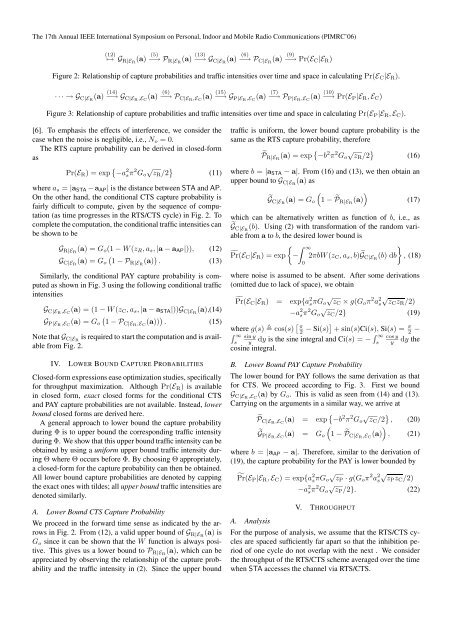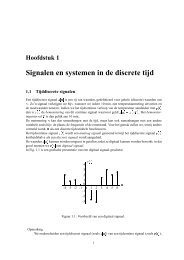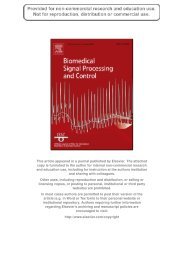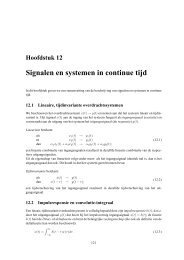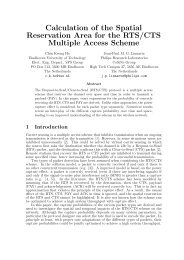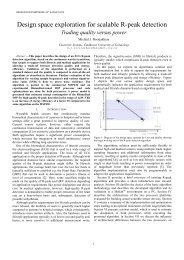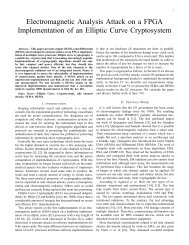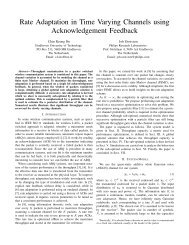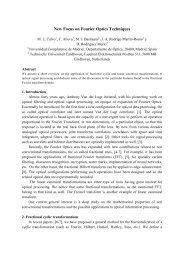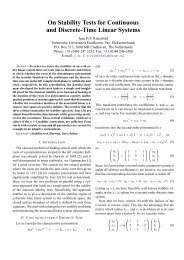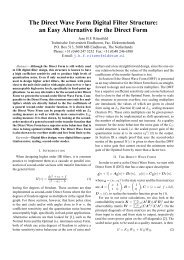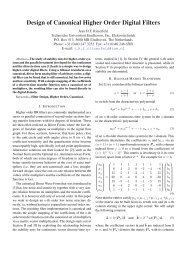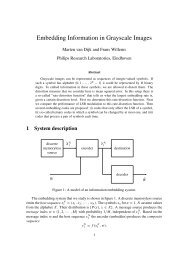analysis of the rts/cts multiple access scheme with capture effect
analysis of the rts/cts multiple access scheme with capture effect
analysis of the rts/cts multiple access scheme with capture effect
Create successful ePaper yourself
Turn your PDF publications into a flip-book with our unique Google optimized e-Paper software.
The 17th Annual IEEE International Symposium on Personal, Indoor and Mobile Radio Communications (PIMRC’06)<br />
(12)<br />
↦→ G R|ER (a) (5)<br />
−→ P R|ER (a) (13)<br />
−→ G C|ER (a) (6)<br />
−→ P C|ER (a) (9)<br />
−→ Pr(E C |E R )<br />
Figure 2: Relationship <strong>of</strong> <strong>capture</strong> probabilities and traffic intensities over time and space in calculating Pr(E C |E R ).<br />
· · · → G C|ER (a) (14)<br />
−→ G C|ER,E C<br />
(a) (6)<br />
−→ P C|ER,E C<br />
(a) (15)<br />
−→ G P|ER,E C<br />
(a) (7)<br />
−→ P P|ER,E C<br />
(a) (10)<br />
−→ Pr(E P |E R , E C )<br />
Figure 3: Relationship <strong>of</strong> <strong>capture</strong> probabilities and traffic intensities over time and space in calculating Pr(E P |E R , E C ).<br />
[6]. To emphasis <strong>the</strong> effe<strong>cts</strong> <strong>of</strong> interference, we consider <strong>the</strong><br />
case when <strong>the</strong> noise is negligible, i.e., N o = 0.<br />
The RTS <strong>capture</strong> probability can be derived in closed-form<br />
as<br />
Pr(E R ) = exp { −a 2 sπ 2 G o<br />
√<br />
zR /2 } (11)<br />
where a s = |a STA − a AP | is <strong>the</strong> distance between STA and AP.<br />
On <strong>the</strong> o<strong>the</strong>r hand, <strong>the</strong> conditional CTS <strong>capture</strong> probability is<br />
fairly difficult to compute, given by <strong>the</strong> sequence <strong>of</strong> computation<br />
(as time progresses in <strong>the</strong> RTS/CTS cycle) in Fig. 2. To<br />
complete <strong>the</strong> computation, <strong>the</strong> conditional traffic intensities can<br />
be shown to be<br />
G R|ER (a) = G o (1 − W (z R , a s , |a − a AP |)), (12)<br />
G C|ER (a) = G o<br />
(<br />
1 − PR|ER (a) ) . (13)<br />
Similarly, <strong>the</strong> conditional PAY <strong>capture</strong> probability is computed<br />
as shown in Fig. 3 using <strong>the</strong> following conditional traffic<br />
intensities<br />
G C|ER,E C<br />
(a) = (1 − W (z C , a s , |a − a STA |))G C|ER (a),(14)<br />
G P|ER,E C<br />
(a) = G o<br />
(<br />
1 − PC|ER,E<br />
C<br />
(a)) ) . (15)<br />
Note that G C|ER is required to start <strong>the</strong> computation and is available<br />
from Fig. 2.<br />
IV.<br />
LOWER BOUND CAPTURE PROBABILITIES<br />
Closed-form expressions ease optimization studies, specifically<br />
for throughput maximization. Although Pr(E R ) is available<br />
in closed form, exact closed forms for <strong>the</strong> conditional CTS<br />
and PAY <strong>capture</strong> probabilities are not available. Instead, lower<br />
bound closed forms are derived here.<br />
A general approach to lower bound <strong>the</strong> <strong>capture</strong> probability<br />
during Φ is to upper bound <strong>the</strong> corresponding traffic intensity<br />
during Φ. We show that this upper bound traffic intensity can be<br />
obtained by using a uniform upper bound traffic intensity during<br />
Θ where Θ occurs before Φ. By choosing Θ appropriately,<br />
a closed-form for <strong>the</strong> <strong>capture</strong> probability can <strong>the</strong>n be obtained.<br />
All lower bound <strong>capture</strong> probabilities are denoted by capping<br />
<strong>the</strong> exact ones <strong>with</strong> tildes; all upper bound traffic intensities are<br />
denoted similarly.<br />
A. Lower Bound CTS Capture Probability<br />
We proceed in <strong>the</strong> forward time sense as indicated by <strong>the</strong> arrows<br />
in Fig. 2. From (12), a valid upper bound <strong>of</strong> G R|ER (a) is<br />
G o since it can be shown that <strong>the</strong> W function is always positive.<br />
This gives us a lower bound to P R|ER (a), which can be<br />
appreciated by observing <strong>the</strong> relationship <strong>of</strong> <strong>the</strong> <strong>capture</strong> probability<br />
and <strong>the</strong> traffic intensity in (2). Since <strong>the</strong> upper bound<br />
traffic is uniform, <strong>the</strong> lower bound <strong>capture</strong> probability is <strong>the</strong><br />
same as <strong>the</strong> RTS <strong>capture</strong> probability, <strong>the</strong>refore<br />
˜P R|ER (a) = exp { −b 2 π 2 G o<br />
√<br />
zR /2 } (16)<br />
where b = |a STA − a|. From (16) and (13), we <strong>the</strong>n obtain an<br />
upper bound to G C|ER (a) as<br />
˜G C|ER (a) = G o<br />
(1 − ˜P<br />
)<br />
R|ER (a)<br />
(17)<br />
which can be alternatively written as function <strong>of</strong> b, i.e., as<br />
˜G C|ER (b). Using (2) <strong>with</strong> transformation <strong>of</strong> <strong>the</strong> random variable<br />
from a to b, <strong>the</strong> desired lower bound is<br />
{ ∫ ∞<br />
}<br />
˜Pr(E C |E R ) = exp − 2πbW (z C , a s , b) ˜G C|ER (b) db , (18)<br />
0<br />
where noise is assumed to be absent. After some derivations<br />
(omitted due to lack <strong>of</strong> space), we obtain<br />
˜Pr(E C |E R ) = exp{a 2 sπG o<br />
√<br />
zC × g(G o π 2 a 2 s√<br />
zC z R /2)<br />
−a 2 sπ 2 G o<br />
√<br />
zC /2} (19)<br />
where g(s) cos(s) [ π<br />
2 − Si(s)] + sin(s)Ci(s), Si(s) =<br />
∫ π 2 −<br />
∞ sin y<br />
s y<br />
dy is <strong>the</strong> sine integral and Ci(s) = − ∫ ∞ cos y<br />
s y<br />
dy <strong>the</strong><br />
cosine integral.<br />
B. Lower Bound PAY Capture Probability<br />
The lower bound for PAY follows <strong>the</strong> same derivation as that<br />
for CTS. We proceed according to Fig. 3. First we bound<br />
G C|ER,E C<br />
(a) by G o . This is valid as seen from (14) and (13).<br />
Carrying on <strong>the</strong> arguments in a similar way, we arrive at<br />
˜P C|ER,E C<br />
(a) = exp { −b 2 π 2 √<br />
G o zC /2 } , (20)<br />
˜G P|ER,E C<br />
(a) = G o<br />
(1 − ˜P<br />
)<br />
C|ER,E C<br />
(a) , (21)<br />
where b = |a AP − a|. Therefore, similar to <strong>the</strong> derivation <strong>of</strong><br />
(19), <strong>the</strong> <strong>capture</strong> probability for <strong>the</strong> PAY is lower bounded by<br />
˜Pr(E P |E R , E C ) = exp{a 2 sπG o<br />
√<br />
zP · g(G o π 2 a 2 s√<br />
zP z C /2)<br />
A. Analysis<br />
−a 2 sπ 2 G o<br />
√<br />
zP /2}. (22)<br />
V. THROUGHPUT<br />
For <strong>the</strong> purpose <strong>of</strong> <strong>analysis</strong>, we assume that <strong>the</strong> RTS/CTS cycles<br />
are spaced sufficiently far apart so that <strong>the</strong> inhibition period<br />
<strong>of</strong> one cycle do not overlap <strong>with</strong> <strong>the</strong> next . We consider<br />
<strong>the</strong> throughput <strong>of</strong> <strong>the</strong> RTS/CTS <strong>scheme</strong> averaged over <strong>the</strong> time<br />
when STA <strong>access</strong>es <strong>the</strong> channel via RTS/CTS.


